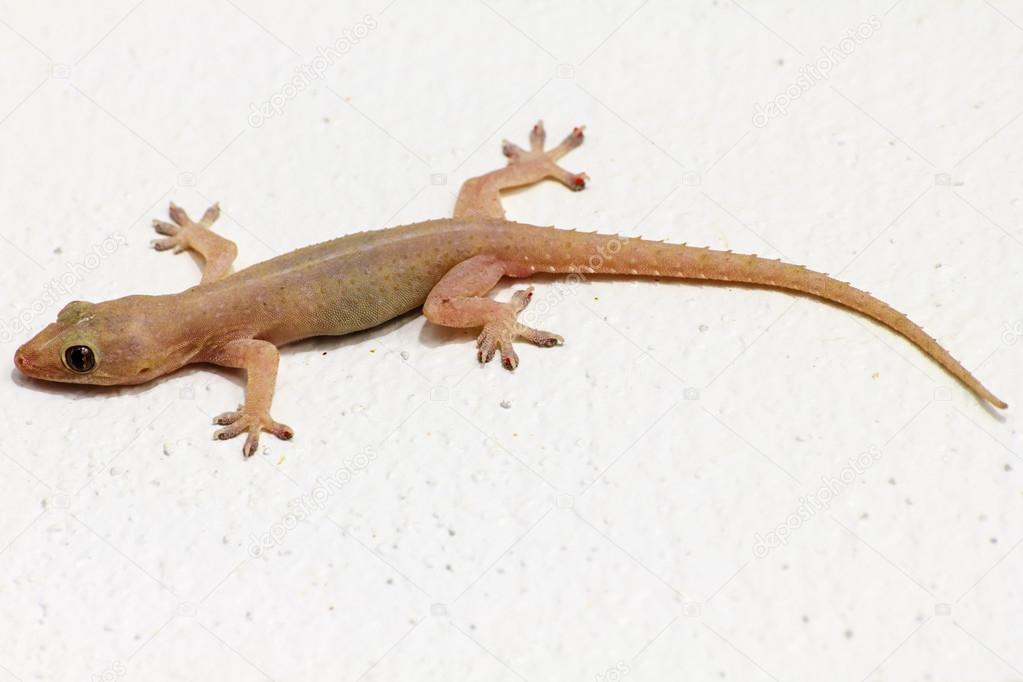Have you ever walked into your living room or kitchen and spotted one of those little lizards chilling on your wall? While they’re considered harmless and eat other insects, having wildlife in your home can be unsettling.
The good news is there are several natural, non-toxic ways to evict these unwanted wall guests and reclaim your space. In this article, we’ll cover some tried-and-true methods for getting rid of wall geckos so you can sleep tight knowing your home is gecko-free.
What Are Wall Geckos?

Wall geckos, also known as house geckos, crocodile geckos or moon lizards, are those little lizards you often spot scurrying across walls and ceilings. Their scientific name is Hemidactylus frenatus. About 5 to 8 inches long, these nocturnal creatures feed on insects and spiders in and around homes.
Why Are Wall Geckos Problematic?
Why are wall geckos problematic? They may seem harmless, but these little lizards can cause damage.
They leave droppings and stains.
Wall geckos excrete waste anywhere they go, leaving unsightly droppings and stains on walls and ceilings that can be difficult to remove. Their sticky feet also leave tracks that attract dirt and grime.
They damage property
Geckos crawl into tiny cracks and crevices, loosening plaster and wall surfaces over time. They’ve been known to chew on wiring, creating fire hazards. And if they make their way inside electronics like AC units, they can short-circuit the equipment.
They reproduce rapidly
A single female can lay up to 10 eggs multiple times a year. Before you know it, you’ll have an infestation of these unwanted reptiles in your home. The babies, called hatchlings, are hard to spot until the problem becomes severe.
They can pose health risks
While rare, gecko droppings and saliva may contain bacteria like Salmonella that can make humans sick. Their discarded skin and nails also contain allergens which trigger reactions in some people.
The bottom line? Wall geckos spell trouble. The best way to prevent damage and health issues is to get rid of them.
Why Do Wall Geckos Enter Homes?
Wall geckos are found throughout tropical and subtropical regions, so they are well-adapted to warm climates. However, there are a few reasons why they may enter homes:
Shelter and habitat loss: As cities expand, geckos lose their natural habitat and shelter. Homes provide them coverage, warmth, and access to insects they feed on.
Food source: Homes contain plenty of small insects like mosquitoes, flies, and spiders that geckos prey on. The easy access to food attracts them inside.
Cracks and crevices: Homes often have small cracks, holes, and openings that give geckos access inside.
Mating and egg laying: During mating season, male and female geckos may enter homes in search of sheltered areas to mate and lay their eggs. Females lay 2 eggs at a time, up to 6 times per year.
Temperature regulation: Geckos are cold-blooded, so they enter homes to find warmer temperatures, especially at night. The stable temperatures inside homes are appealing for geckos.
In summary, geckos enter homes primarily seeking shelter, food, and warmth.
How to Get Rid of Wall Geckos
Here are some ways to get rid of wall Geckos in your home;
Use Pesticides
To fully get rid of wall geckos, you’ll need to use pesticides. Apply an insecticide spray; pesticides are effective at killing geckos.
Spray anywhere you see geckos entering, like cracks and crevices in walls, as well as anywhere else they may be accessing the inside of your home. You should also spray areas where you see gecko droppings or hear gecko calls and noises.
Be very careful when applying pesticides, and be sure to follow all instructions and safety precautions listed on the product packaging. Ventilate the area well and avoid contact with treated surfaces. You may need to reapply the pesticide a few times to fully eliminate an infestation.
Note: Only use pesticides when absolutely necessary and according to the instructions.
Use sticky traps
Sticky traps are a simple but effective way to catch and remove wall geckos.
Place traps along walls, Put sticky traps, like double-sided tape or glue boards, along walls in areas where you see gecko activity or droppings. Geckos stick to these traps as they walk along walls, getting stuck in place. Place several small traps, rather than one large one, to maximize the chance of catching your unwanted house guests.
Check and replace the traps regularly to catch any geckos still in the area. Be very careful when removing stuck geckos, as they may still be alive and able to bite. Wear thick gloves and dispose of the geckos, and used traps properly according to the product instructions.
Note: Sticky traps are a humane, non-toxic way to eliminate your wall gecko problem. With consistent use and placement in key areas, you’ll get rid of these unwanted visitors in no time.
Seasonal fumigation of your home
Seasonal fumigation of your home is an effective way to eliminate wall geckos and prevent re-infestation.
Every 3-6 months, hire an exterminator to spray your home, especially entry points like cracks and crevices in exterior walls, with an insecticide containing bifenthrin or permethrin. These chemicals are effective at killing wall geckos and deterring them from entering your home.
For the best results, combine seasonal fumigation with good home maintenance. An integrated pest management approach will make your home unappealing to unwanted wall geckos and other pests.
Avoid everything that may make your home comfortable for them
To avoid making your home more gecko-friendly, seal up any cracks or crevices in walls, ceilings, attics, basements and roofs where geckos can enter.
Inspect the exterior of your home and look for any openings wider than 1/4 inch; once you notice it, seal it. The fewer ways in, the fewer spots geckos have to set up camp.
Staying on top of maintenance and fixes will help ensure they don’t return. The key is keeping your home less comfortable and accommodating so geckos go elsewhere.
How to Prevent Wall Geckos From Re-Entering Your Home
To prevent wall geckos from entering your home, here are some tips:
Seal any cracks or crevices
Wall geckos can enter through very small openings, so thoroughly inspect the exterior of your home for any cracks or holes in foundations, windows, doors, attics, or basements, and repair or seal them.
Install tight-fitting screens
Make sure any vents, exhaust fans, doors or windows have tight-fitting, secure screens to block geckos and other pests. Repair or replace any damaged or loose-fitting screens.
Remove access to food sources
Clear your surroundings of any debris, wood piles, compost bins or trash that can attract the insects geckos feed on. Store foods in airtight containers and clean up food waste to eliminate access to a food source.
Apply natural repellents
Apply natural essential oils with a strong smell around entry points, such as eucalyptus, lavender, citronella or peppermint oil. The strong smell will deter geckos.
Install barriers
Place double-sided tape, copper mesh tape, lattice, netting or screen barriers over areas where geckos may enter. The sticky, sharp or obstructing surfaces make access difficult and unappealing.
Practice good sanitation
Practice good sanitation like clearing standing water, fixing any leaky faucets, cleaning up food waste and other clutter where insects can breed. Removing access to food sources and shelter will make your home less gecko-friendly.
Conclusion
So there you have it, a few easy steps to get rid of those annoying wall geckos once and for all. It may take a little time and patience, but with some diligent sealing of entry points, trapping, and repelling, you’ll be enjoying gecko-free living spaces in no time.
Stay vigilant, keep sealing up any new cracks or holes, and keep using natural repellents for the best results. Before you know it, wall geckos will be a thing of the past.









Discussion about this post